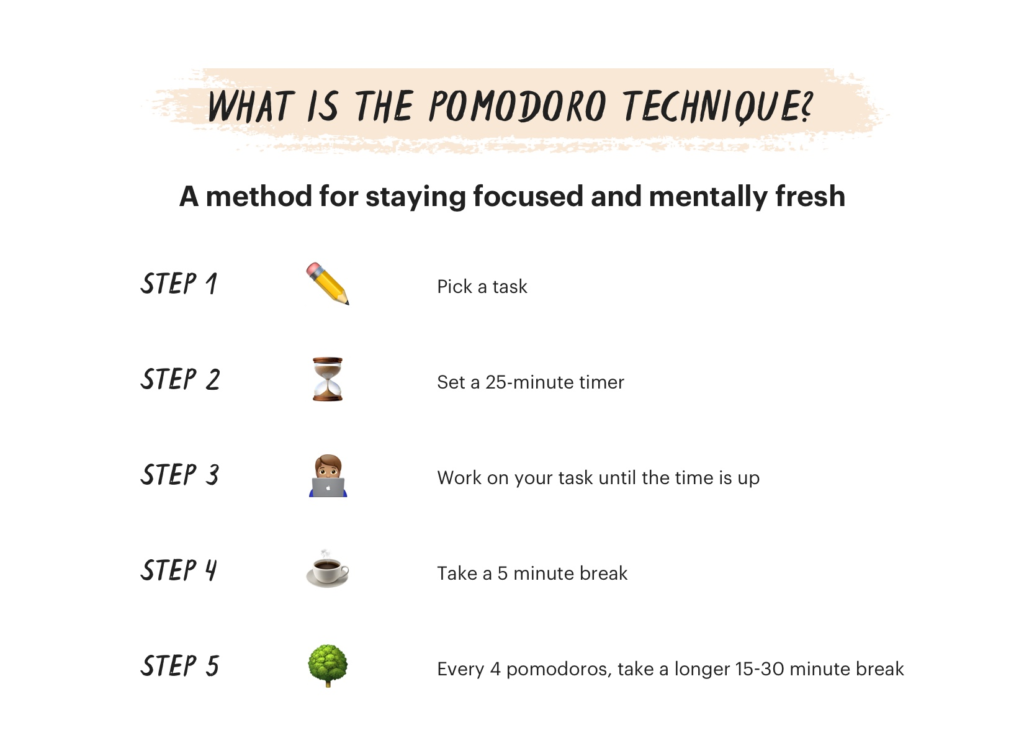Welcome to Part 1 of our Study Effectively series! In this series, we cover tips and tricks to help students find the best revision method to prepare for their upcoming exams.
You may have heard of the relatively popular study method known as the Pomodoro Technique. If you’re not quite sure how it works or what it can help you to achieve, read on to find out!
What is the Pomodoro technique?
The Pomodoro technique is a time management system, designed to increase focus and enhance one’s productivity. ‘Pomodoros’ refer to 25-minute intervals that are separated by 5-minute breaks. This simple yet effective method can be applied across any task that you are working on, including long-term study goals.
The technique was first developed in the late 1980s by a university student who struggled to stay focused on his assignments; which is a common problem that we can all relate to!
Why is it effective?
Let’s say you have a goal of trying to memorise five chapters worth of information for your upcoming Biology exam.
Many students would opt to re-read the five chapters over the course of many hours over many days. However, they may find themselves at a loss during a mock exam when they find it difficult to recall what they have studied. This is because your brain finds it hard to retain information without sufficient breaks to review the content you’ve just learned.
By using the Pomodoro technique, you break up your day-long study sessions over many “Pomodoros”, where you study and review after each break. This helps you by:
1. Making it easier to hit study goals
Having difficulty in finding the motivation to even get started on your revision? The Pomodoro technique encourages you to slowly tackle a complex goal over many smaller and more manageable intervals of 25 minutes, making the revision process a whole lot less overwhelming.
For example, instead of trying to cover the content of all 5 topics in one sitting, you can strive to complete a topic over 2 or more pomodoros. By sectioning the work into smaller segments, it helps to motivate you by giving you the feeling of achieving many short-term goals.
Plus, by giving yourself a break after each segment of time, you also encourages you to reward yourself for every bit of progress that you have achieved in your studies.
2. Being more conscious of your allocation of time
When preparing for major exams, it is often easy to spend too much time on a single subject, hence neglecting other subjects. We are also often susceptible to the planning fallacy: which is a tendency to underestimate the amount of time needed to complete a certain task. Thus, we may mismanage our time more.
The Pomodoro technique allows you to allocate the time you have between the tasks on hand appropriately, and plan your days more efficiently. With practice, you will gain a better sense on the optimal amount of time to spend on a topic, and the areas where you may need extra help in.
3. Instilling a sense of urgency to combat distractions
Instead of focusing on the fact that you have an entire day’s worth of time to cover the necessary content, you are likely to be more eager to make as much progress as possible within each short period of time.
Not only does this ensure that you are spending your time more productively, you are also less likely to succumb to the distractions around you, which can break your focus and result in more precious time wasted.
4. Enhancing productivity by preventing potential burn out
A common misconception is that we can maximise our productivity by “cramming” as much content as possible when we study. However, it tends to lead to more exhaustion and eventual burnout over long hours at our desks.
With the Pomodoro Technique, each 5-minute break allows you to refresh your mind from the content, before bringing your attention to it again after the break. By enhancing your focus, you are likely to retain more information each time.
The quick breaks that you reward yourself with is also an effective way of preventing the feeling of being burnt out, allowing long hours or even weeks of studying to be more sustainable.
How do I make use of the Pomodoro Technique?

- Start your day with a clear plan, with tasks you want to achieve.
- Use a timer app to keep track of your time, preferably one that allows you to adjust the duration of each working session and each break.
- Reflect on what went well at the end of each day, and experiment with the duration of each interval to find out what works best for you.
For those who are used to working for long hours on end or are easily distracted throughout the day, the Pomodoro Technique may be worth a try!
Another way of enhancing your productivity is to ensure that you have the right materials that aids in your revision! Do check out our wide range of assessment and guidebooks for students! We offer assessment books and guidebooks for all levels, including pre-school, primary, secondary and JC. Head to our CPD online shop today!

